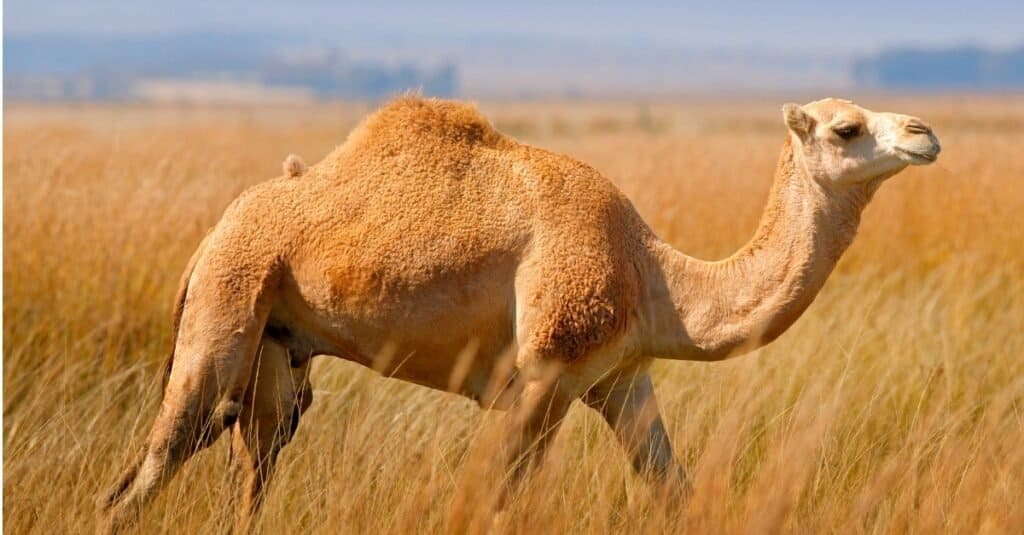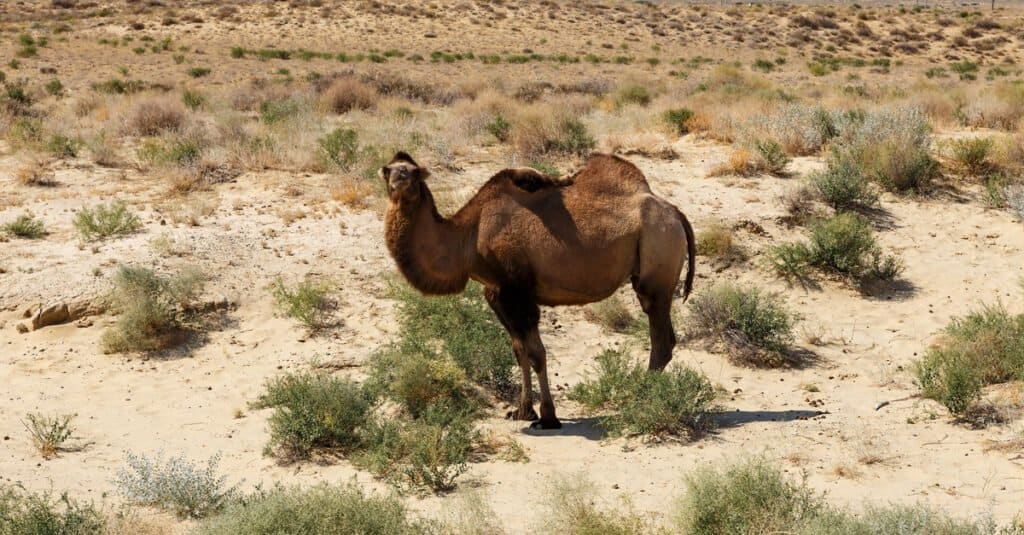Camels! Can’t you just see them traveling across the desert sand with their humps silhouetted against the glorious sunset? They seem to always know where they’re going and what they’re about to get into. But even in this day and age of all information being at our fingertips, their ever-present “smiles” seem to mask secrets we can’t quite put our fingers on. Maybe the biggest question there is about these magnificent creatures is, “Why do camels have humps?”
So, Why Do Camels Have Bumps?

A dromedary near the sea in the Oman empty quarter of the desert.
Camels are opportunistic foragers that can eat
even thorny plants.
©lkpro/Shutterstock.com
The story has been widely told that camels store water in their humps. Newsflash for the day: They don’t. Truth is, their humps hold stored fats to use as backup during food shortages and for their long journeys.
“That’s right, fat. Each hump can store up to 36 kilograms of it, which can sustain the camel for weeks or even months without food.” — Business Insider
That would be a whopping 80 lbs(!) of fat. If those reserves are used, the humps begin to physically change, deflate, and droop over the camel’s backbone.
Camel fat is a super food’s super food. One tablespoon has three times the amount of oleic acid than coconut oil. No wonder they can go several months without food.
In short, camels have humps because they possess incredibly nutritious fat reserves that can allow them to go long periods without food while wandering through deserts.
How Can Camels Go Without Water for So Long?

Dromedary or Arabian camel, Camelus dromedarius, in the long golden grass in an Egyptian meadow.
©Ondrej Prosicky/Shutterstock.com
The tale is true that camels can go at least a week without water. It works like this:
Camels have extremely elastic blood cells and capillaries that run throughout their bodies, including the hump, that hold larger amounts of water when they do drink.
They gorge on the liquid gold when they find it, expanding their cells up to 240%, until their stomachs protrude. They can drink up to 30 gallons of water in ten minutes.
Simply put, they get their water from their own blood. The wild Bactrian camel of China can even survive on saltwater!
Eating green vegetation can also provide sufficient moisture to help them maintain hydration. Additionally, when they exhale, water vapor is trapped in their nostrils and reabsorbed into the body to conserve water. These desert dwellers are fascinating.
Camel Facts: The 3 Species of Camels

Bactarian camels have two humps and live in Asia
©Mikhail Priakhin/Shutterstock.com
There are three extant species of camels:
- Dromedary (Arabian): One-hump
- Bactarian: Two-humps
- Wild Bactarian: Two-humps
Dromedary camel statistics (One hump):
Domesticated: Yes
Habitat: Semi-arid and arid. North Africa and the Middle East, the Sahara Desert
Unique characteristics: Horny pads on the chest and knees for protection against the sand’s heat, narrow chest, and long hairs on the hump, shoulders, and throat
Weight: 600-1,300 lbs.
Population: 94% of camel population
Coat color: Brown, black, even white
Bactrian camel statistics (Two humps):
Domesticated: Yes
Habitat: Flat, arid deserts, sand dunes, rocky mountains, and stony
plains. Central Asian steppes
Weight: 600-2,200 lbs.
Population: 6% of camel population
Coat color: Varies from sandy beige to dark brown
Unique characteristics: Darker, stockier, and woolier than the Wild Bactrian
Wild Bactrian camel statistics (Two humps):
Domesticated: No
Habitat: Parts of northwestern China, southwestern Mongolia, and Australia (Remote and wild regions of the Taklamakan and Gobi Deserts). Arid plains and hills
Diet: Mostly shrubs
Population: Critically endangered
Unique characteristics: Thinner legs, smaller humps, narrow feet, and less hair than the Bactrian
The wild Bactrian camel is on the critically endangered IUCN Red List due to hunters placing landmines by saltwater springs, poaching, wolf attacks, hybridization with domesticated Bactrian camels, and lack of access to oases water sources due to human interference.
Camels: The Ultimate Desert Animal
Camels are a beast of burden (an animal employed to carry heavy loads or to perform other heavy work such as pulling a plow). People who live in the desert depend on them for:
- Travel
- Meat
- Milk
- Labor
- Dung used for fuel
- And textiles like felt made rom camel hair
To protect them from desert sand storms, camels have two rows of eyelashes and nostrils that are sealable and can close completely shut. A thin, clear membrane that covers each eye also serves as protection.
Their feet are tough and wide which allows them to navigate on the desert floor. They can use those feet to walk 20 miles per day sometimes with heavy loads, weighing hundreds of pounds, on their backs.
Camels are active during the day (diurnal) and spend their time mostly eating when food is available. Their upper lips are split and move independently making it easy to eat short grass. With the tough leathery texture of their tongues, they eat dry, bitter, thorny, and salty plants.
They’re mostly herbivores with one caveat: When food is scarce, they sometimes feed on carcasses and even fish is on the menu. Hey, when you get hungry…
The human side of camels

The dromedary camel is capable of drinking 100 L (30 gal.) of water in just 10 minutes and can tolerate water loss equal to over 30% of their body weight.
©Fabian Junge/Shutterstock.com
Camels are highly sociable animals and in herds will sometimes blow in each other’s faces as a friendly gesture.
There are around 20 camels in each flock led by a dominant male. When mating season arrives, male Dromedary camels signal it by foaming at the mouth and hanging their bulging soft palates completely out of their mouths so the females will take notice. (I dare not say a word about potential similarities to humans.)
This behavior is confirmed by scientists and has been sufficiently visually recorded.
Female camels usually only bear one calf and although it’s extremely rare, sometimes twins are born. A mother and her offspring have been known to actually hum to each other.
Even though they’re usually docile, easy-going, and calm, these animals get agitated like the rest of us and can bite or kick when they do. They’re also fairly famous for their ability to spit when they feel threatened. They raise their chin, lower their ears, and let it fly.
One last note: Can you believe that…
… Camels can live in temperatures from minus 20 degrees Fahrenheit to 120 degrees Fahrenheit.
And there you have it — Now you know about camels’ tongues, what makes them hum, and why they have humps. Don’t you feel better?
The photo featured at the top of this post is © Photoestetica/Shutterstock.com
Thank you for reading! Have some feedback for us? Contact the AZ Animals editorial team.






